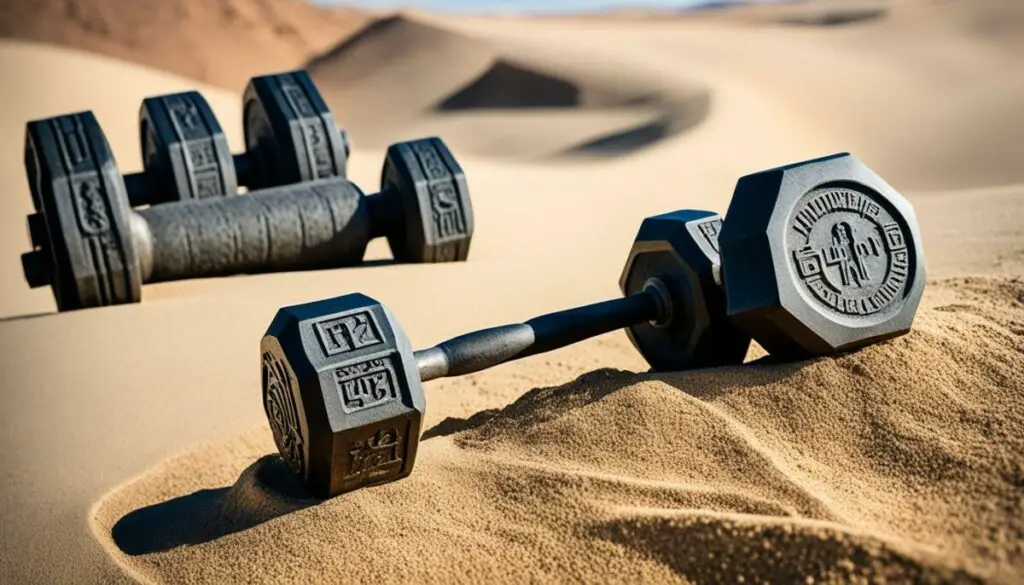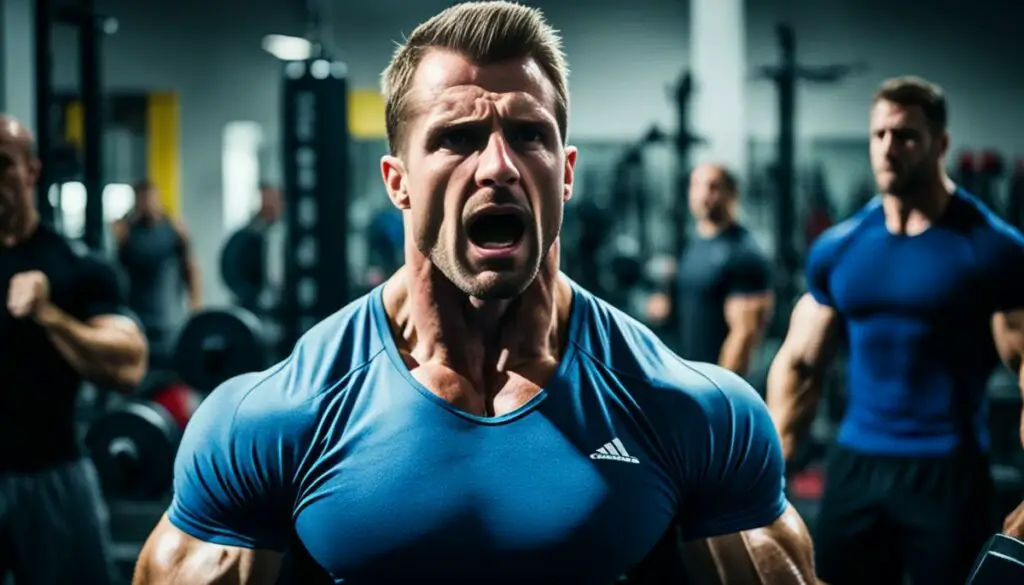Last Updated on 3 months by Francis
Have you ever wondered how to lift the unliftable dumbbell? Well, you’re not alone. Lifting heavy dumbbells is a challenge that many strength enthusiasts aspire to conquer. Whether you’re looking to push your limits or break through lifting plateaus, we’ve got you covered with some expert tips and techniques.
In this article, we’ll delve into the history of the unliftable dumbbell, discuss the mental barrier associated with heavy lifting, explore proper technique and progressive strength training methods, and share insights on nutrition and recovery. By the end, you’ll have a comprehensive understanding of how to tackle this impressive feat and achieve your personal best in dumbbell lifts!
Contents
Key Takeaways:
- Proper technique and strength training strategies are crucial for lifting heavy dumbbells.
- Understanding the history of the unliftable dumbbell can help set realistic expectations.
- Overcoming the mental barrier is just as important as building physical strength.
- Progressive strength training and balanced nutrition support strength gains.
- Balancing strength and mobility is essential for optimal performance and injury prevention.
Understanding the History of the Unliftable Dumbbell

Thomas Inch, a renowned strongman from the early 1900s, achieved fame through his claim of lifting the seemingly unliftable 172-pound Inch Challenge Dumbbell. This feat, however, has been the subject of skepticism due to the absence of concrete evidence showcasing him lifting the dumbbell overhead. Despite the uncertainty surrounding Inch’s claims, exploring the history of the unliftable dumbbell can provide valuable insights that help us approach the challenge with a critical mindset and realistic expectations.
“The Inch Challenge Dumbbell, purported to weigh 172 pounds, has become iconic in the world of strength training. It represents a significant milestone in the pursuit of pushing the limits of human strength. However, doubts exist about Thomas Inch’s alleged accomplishments with this formidable piece of equipment.” – Expert Strongman Historian
To fully comprehend the context of the unliftable dumbbell, it is essential to delve into the story of Thomas Inch. Born in 1881 in England, Inch was a pioneer in the world of strength and physical culture. He gained a reputation for his remarkable feats of strength and the development of unique training apparatus.
One of Inch’s most well-known creations was the Inch Challenge Dumbbell— a cylindrical dumbbell with a handle with a diameter of 2.38 inches. This specialized design challenged conventional training methods and became a symbol of extreme strength. It is important to note that the Inch Challenge Dumbbell was not just heavy, but also uniquely challenging due to its non-standard grip.
Despite Inch’s claim of repeatedly lifting the Inch Challenge Dumbbell overhead, no photographic evidence or credible eyewitness accounts have surfaced to substantiate these assertions. This absence of proof has fueled speculation about the authenticity of his claims and cast a shadow of doubt over the legendary unliftable dumbbell.
However, while the details of Inch’s achievements may remain shrouded in uncertainty, his legacy lives on in the world of strength training. His notable contributions have sparked interest and inspired countless individuals to challenge their own physical limitations.
By acknowledging the historical context surrounding the unliftable dumbbell, we can approach the challenge with a balanced perspective. Understanding the potential discrepancies in Inch’s claims allows us to maintain a critical mindset while pursuing our own goals and pushing our lifting plateaus. It encourages us to focus on the process of strength development, proper technique, and progressive training strategies rather than solely fixating on achieving a single, elusive lift.
“The Inch Challenge Dumbbell’s history imbues it with a mystique that extends beyond the realm of physical strength. By appreciating the challenges associated with this iconic dumbbell, we can embrace the true essence of strength training: the relentless pursuit of self-improvement and the continual quest to surpass our own limitations.” – Strength Training Enthusiast
Through a critical examination of the unliftable dumbbell’s history, we can approach our own training endeavors with a sense of curiosity and a commitment to realistic progress. By acknowledging the potential discrepancies and embracing the lessons drawn from the past, we can navigate the challenges of strength training with an informed perspective and a greater likelihood of success.
| Key Elements | Significance |
|---|---|
| Thomas Inch | Renowned strongman, creator of Inch Challenge Dumbbell |
| Inch Challenge Dumbbell | Seemingly unliftable 172-pound dumbbell |
| Doubts and Skepticism | Absence of evidence supporting Inch’s claims |
| Historical Context | Understanding Inch’s contributions to strength training |
| Lessons and Approach | Applying a critical mindset and realistic expectations |
Overcoming the Mental Barrier

Lifting an unliftable dumbbell requires not only physical strength but also mental fortitude. The mental barrier that comes with attempting such a challenging feat can be daunting. However, with the right mindset and mental strategies, it is possible to overcome these obstacles and achieve breakthroughs in dumbbell lifting.
Emphasizing a positive mindset is crucial when faced with dumbbell lifting challenges. By focusing on the belief that you can overcome the task at hand, you can tap into your inner strength and push past any self-doubt. Visualizing success, envisioning yourself lifting the unliftable dumbbell with ease, can help build confidence and prepare your mind for the physical demands of the lift.
“Success is not final, failure is not fatal: It is the courage to continue that counts.” – Winston Churchill
The quote above highlights the importance of perseverance, particularly when faced with difficult challenges. It reminds us that success is not guaranteed on the first try but is determined by our willingness to persist and learn from failures.
Overcoming the mental barrier also involves setting realistic expectations and breaking down the challenge into smaller milestones. Celebrate each achievement along the way and acknowledge the progress made, regardless of how incremental it may seem.
It’s worth noting that everyone’s mental barriers may differ, and what works for one person may not necessarily work for another. Experimenting with different strategies, such as meditation, positive affirmations, or seeking support from a coach or training partner, can help you find the methods that best suit your mindset.
The key to success lies in training both the body and the mind. By strengthening your mental resilience alongside your physical abilities, you can break through the mental barriers that stand between you and your strength training breakthroughs.
Mastering Proper Technique

To successfully lift an unliftable dumbbell, mastering proper technique is essential. This involves developing grip strength, maintaining proper body alignment, and engaging the correct muscle groups. By incorporating unconventional dumbbell exercises and implementing maximal dumbbell lifting strategies, you can enhance your strength and technique, setting yourself up for success in conquering this challenging feat.
Developing Grip Strength
One key aspect of proper technique is having a strong grip. A solid grip on the dumbbell allows you to maintain control and stability during the lift. To develop grip strength, consider incorporating exercises such as farmer’s walks, hanging from a pull-up bar, or using grip strengtheners. These exercises target the muscles in your forearms and hands, improving your ability to hold onto the dumbbell securely.
Ensuring Proper Body Alignment
Proper body alignment is crucial when lifting heavy dumbbells. By aligning your body correctly, you can maximize your strength and minimize the risk of injury. Focus on these key alignment points:
- Keep your feet shoulder-width apart for a stable base of support.
- Maintain a neutral spine position by engaging your core muscles.
- Keep your shoulders down and back, away from your ears.
- Align your wrists with your forearms to ensure proper joint position.
Engaging the Correct Muscle Groups
Engaging the correct muscles is essential for a successful dumbbell lift. The primary muscles targeted during the lift are typically the shoulders, chest, and arms. It is important to focus on these muscle groups and ensure they are activated throughout the movement. By using proper form and technique, you can effectively target and engage these muscles, optimizing your lifting performance.
Here is an example of a maximal dumbbell lifting strategy:
Strategy: Pyramid Sets
Pyramid sets involve gradually increasing the weight with each set, aiming to reach a maximum load and then decreasing the weight back down.
Set Repetitions Weight (lbs) 1 12 30 2 10 40 3 8 50 4 6 60 5 4 70 6 2 80 7 1 90 8 1 80 9 1 70 10 1 60 11 1 50 12 1 40
By incorporating these techniques and strategies into your training routine, you can develop the necessary strength and technique to lift an unliftable dumbbell.
Progressive Strength Training

Building the strength necessary to lift heavier dumbbells and achieve personal bests requires a progressive approach to strength training. By gradually increasing the weight and intensity of your dumbbell workouts, you can challenge your muscles, stimulate growth, and overcome your limits. Here are some heavy dumbbell lifting tips to help you reach your goals:
- Start with a solid foundation: Before diving into heavy dumbbell lifting, make sure you have mastered proper technique and have built a solid foundation of strength. Focus on mastering the basics and gradually increase the weight as your proficiency improves.
- Set realistic goals: While it’s great to aim high and push yourself, it’s important to set realistic goals that align with your current fitness level. This will help you stay motivated and avoid injury.
- Follow a structured training program: Having a structured training program is key to progressing in your dumbbell lifts. This will ensure that you are consistently challenging yourself and gradually increasing the weight and intensity over time.
- Incorporate progressive overload: Progressive overload is the gradual increase in stress placed on the body during training. This can be achieved by adding more weight, increasing the number of sets or reps, or decreasing rest time between sets. It’s important to progressively overload your muscles to continue making progress.
- Listen to your body: Pay attention to how your body feels during your workouts. If you feel any pain or discomfort, it’s essential to address it and make any necessary modifications to your training program. Rest and recovery are vital components of progressive strength training.
Personal Best Progress Chart
| Date | Exercise | Weight (lbs) | Reps |
|---|---|---|---|
| July 1, 20XX | Dumbbell Bench Press | 40 | 8 |
| August 1, 20XX | Dumbbell Bench Press | 45 | 6 |
| September 1, 20XX | Dumbbell Bench Press | 50 | 4 |
| October 1, 20XX | Dumbbell Bench Press | 55 | 3 |
| November 1, 20XX | Dumbbell Bench Press | 60 | 2 |
Use this personal best progress chart to track your progress as you gradually increase the weight in your dumbbell lifts. It’s a great way to measure your improvements and celebrate your achievements along the way.
Balancing Strength and Mobility

When training to lift the unliftable dumbbell, it is important to strike a balance between strength and mobility. While building strength is crucial, maintaining mobility and flexibility in your joints and muscles is equally important. Incorporating mobility exercises, stretching, and foam rolling into your training routine can help prevent injuries and optimize your lifting performance.
The Importance of Mobility
Good mobility allows your joints to move freely through their full range of motion, which is essential for executing proper lifting techniques and reducing the risk of injury. It enables you to perform exercises with greater ease and efficiency, translating into improved strength gains.
When it comes to dumbbell lifting, specific mobility exercises can target the muscle groups and joints involved in various lifts. For example, performing shoulder dislocations with a resistance band can improve shoulder mobility, while hip mobility exercises like hip rotations can enhance your range of motion for exercises like squats and lunges.
Stretching for Enhanced Performance
Incorporating stretching into your training routine can help improve your flexibility and range of motion. Dynamic stretching, which involves actively moving your joints through a full range of motion, is particularly beneficial for warming up before strength training.
Focusing on stretches that target the muscles you’ll be using during your dumbbell lifts can help optimize your performance. For example, performing stretches that focus on your chest, shoulders, and triceps can benefit exercises like dumbbell bench press or shoulder press.
Foam Rolling for Muscle Recovery
Foam rolling is a self-myofascial release technique that involves using a foam roller to apply pressure to tight or sore muscles. This can help improve blood flow, release tension, and enhance muscle recovery.
To incorporate foam rolling into your training routine, spend a few minutes before and after your workout targeting the major muscle groups involved in your dumbbell lifts. Roll slowly and pause on any tight or tender areas, applying gentle pressure to encourage release.
| Exercise | Targeted Muscle Group |
|---|---|
| Shoulder Dislocations | Shoulders |
| Hip Rotations | Hips |
| Chest Stretch | Chest, Shoulders |
| Triceps Stretch | Triceps |
By incorporating mobility exercises, stretching, and foam rolling into your training routine, you can improve your overall movement quality, reduce the risk of injury, and optimize your performance in dumbbell lifting. Remember to listen to your body and consult with a fitness professional if you have any concerns or specific mobility limitations.
Nutrition and Recovery
Proper nutrition and recovery are essential components in achieving strength training breakthroughs and reaching your personal best in dumbbell lifts. It’s not just about pushing your body to its limits; it’s also about properly fueling and caring for it.
When it comes to nutrition, focus on maintaining a balanced diet that includes sufficient protein, carbohydrates, and healthy fats. Protein is crucial for muscle repair and growth, while carbohydrates provide the energy needed to fuel intense workouts. Healthy fats, such as those found in avocados and nuts, support overall health and hormone production.
Fueling Your Body for Success
Include lean sources of protein, such as chicken, fish, and tofu, in your diet to support muscle recovery and development. Aim for a moderate intake of carbohydrates, opting for whole grains, fruits, and vegetables. These provide slow-releasing energy and essential nutrients. Don’t forget to incorporate healthy fats from sources like olive oil, nuts, and seeds.
“Proper nutrition plays a vital role in supporting muscle growth and recovery. It’s like giving your body the best building materials to repair and strengthen itself after demanding workouts.”
The Power of Recovery
Recovery is just as important as the training itself. When you expose your body to intense lifting sessions, it undergoes micro-tears that need time to heal and repair. Adequate sleep and rest days are crucial for allowing your body to recover and adapt to the demands of heavy lifting.
Ensure you are getting 7-9 hours of quality sleep each night to support proper hormone production and muscle recovery. Additionally, incorporate active recovery techniques, such as foam rolling, stretching, and low-intensity activities like walking or yoga, to improve blood flow and relieve muscle tension.
“Finding the right balance between training and recovery is key to avoiding burnout and achieving long-term success in your dumbbell lifts.”
Stay Hydrated
Hydration is often overlooked but plays a crucial role in optimal performance and recovery. Aim to drink at least 8-10 glasses of water throughout the day, replenishing fluids lost during workouts. Proper hydration supports nutrient transport, joint lubrication, and temperature regulation, all of which are essential for efficient muscle function.
Pushing Past Plateaus
Plateaus are a common occurrence in strength training. Whether it’s hitting a wall with your bench press or struggling to make progress in your dumbbell lifts, it can be frustrating when you feel stuck. The challenge of lifting the unliftable dumbbell adds its own unique set of obstacles to overcome, but with the right strategies, you can break through these plateaus and continue making progress.
One effective method for overcoming lifting plateaus is to incorporate progressive overload into your training routine. This involves gradually increasing the weight, repetitions, or intensity of your exercises over time. By continuously challenging your muscles to adapt to higher demands, you can stimulate further strength gains and overcome plateau points in your dumbbell lifts.
Resistance training is another technique that can help you push past plateaus. By incorporating resistance bands, chains, or other forms of added resistance into your workouts, you can target different muscle fibers and increase the challenge of your exercises. This variation and increased resistance can disrupt your body’s adaptation process, helping you overcome lifting plateaus.
Periodization is a strategic approach to training that involves dividing your workouts into different phases, each with specific goals and training intensities. By manipulating variables such as volume, intensity, and frequency, you can prevent stagnation and push through plateaus. Periodization allows you to systematically increase the demands on your muscles and avoid reaching a performance plateau.
Advanced Techniques to Break Through Plateaus
When you find yourself stuck at a plateau, incorporating advanced techniques into your training can provide the stimulus needed for progress. One example is utilizing drop sets, where you perform an exercise with a heavy weight until failure and then immediately reduce the weight and continue the set. This technique helps exhaust your muscles and recruit more muscle fibers, promoting greater strength gains.
“Pushing through plateaus requires a combination of mental and physical strategies. By implementing progressive overload, resistance training, and periodization, you can continuously challenge your body and overcome lifting plateaus in your dumbbell lifts.”
Another technique to consider is employing supersets, which involve performing two different exercises back-to-back with little to no rest in between. This technique increases the intensity of your workout and can help break through stagnant points in your training. For example, you could perform dumbbell shoulder presses immediately followed by lateral raises, targeting different muscle groups and stimulating further growth.
Additionally, manipulating your tempo during exercises can be an effective way to overcome plateaus. By slowing down the eccentric (lowering) phase of your lifts, you increase the time under tension and place greater stress on your muscles. This can lead to greater adaptations and improvements in strength.
Tracking Your Progress and Staying Motivated
In order to effectively push past plateaus and track your progress, it’s important to keep a detailed record of your workouts. This can include noting the weights, sets, and reps you perform for each exercise, as well as any modifications or techniques you incorporate. By tracking your progress, you can identify patterns and adjust your training approach accordingly to break through plateaus.
“To break through plateaus, it’s crucial to stay motivated and maintain a positive mindset. Celebrate small victories, set realistic goals, and surround yourself with a supportive community of fellow lifters who can provide encouragement and accountability.”
Remember, overcoming lifting plateaus is a gradual process that requires consistency, patience, and determination. Stay focused on your goals, implement effective training techniques, and don’t be afraid to challenge yourself. With perseverance and the right strategies, you can push through plateaus and continue making progress in your dumbbell lifts.
Conclusion
Don’t let the challenge of lifting the unliftable dumbbell discourage you. Despite its daunting nature, achieving your personal best in difficult dumbbell lifts is possible through the right approach. To conquer this feat, it’s crucial to prioritize a realistic mindset, proper technique, and progressive strength training.
Approach the challenge by setting realistic expectations and understanding that it takes time and effort to develop the necessary strength and skill. Focus on perfecting your form, engaging the correct muscle groups, and gradually increasing the weight and intensity of your workouts.
Consistency and discipline are essential in overcoming plateaus and achieving new personal bests. Push yourself beyond your comfort zone, embrace the journey, and celebrate every small improvement along the way. Remember, even the most difficult dumbbell lifts can be conquered with determination, perseverance, and a commitment to self-improvement.
FAQ
How can I lift the unliftable dumbbell?
Lifting the unliftable dumbbell requires mastering proper technique, progressively increasing strength, and adopting a positive mindset. Incorporating unconventional exercises and maximal lifting strategies can also help you conquer the challenge.
Is there any evidence of Thomas Inch lifting the 172-pound Inch Challenge Dumbbell?
There is no photographic evidence or witness accounts of Thomas Inch lifting the dumbbell overhead, casting doubts on the authenticity of his claim.
How can I overcome the mental barrier of lifting heavy dumbbells?
By adopting a positive mindset, visualizing success, and pushing through the mental hurdles, you can overcome the challenges of lifting heavy dumbbells and achieve new personal bests.
What are some tips and techniques for mastering proper technique in dumbbell lifting?
Focusing on grip strength, maintaining proper body alignment, and engaging the correct muscle groups are important elements of mastering proper technique in dumbbell lifting. Incorporating unconventional exercises and maximal lifting strategies can also enhance your technique.
How can I progressively increase my strength in dumbbell lifts?
Progressive strength training involves gradually increasing the weight and intensity of your dumbbell workouts over time. By consistently challenging yourself with heavier weights and following a structured training program, you can build the necessary strength to lift heavier dumbbells.
How can I strike a balance between strength and mobility in dumbbell lifting?
While building strength is important, maintaining mobility and flexibility in your joints and muscles is equally crucial. Incorporating mobility exercises, stretching, and foam rolling into your training routine can help optimize your lifting performance while reducing the risk of injuries.
What role does nutrition and recovery play in achieving personal bests in dumbbell lifts?
Proper nutrition, including sufficient protein, carbohydrates, and healthy fats, is essential for supporting muscle growth and recovery. Adequate sleep and rest days are also vital for allowing your body to repair and adapt to the demands of heavy lifting, thereby maximizing your lifting performance.
How can I overcome lifting plateaus in my dumbbell lifts?
To overcome lifting plateaus, you can incorporate various training methods such as progressive overload, resistance training, and periodization. Changing up your routine, increasing intensity, and using advanced techniques can help break through plateau points and continue making progress in your dumbbell lifts.
Are difficult dumbbell lifts achievable with the right approach?
Yes, with the right mindset, technique, and progressive strength training, you can conquer difficult dumbbell lifts and achieve personal bests. It’s important to approach the challenge with realistic expectations and prioritize proper form, strength development, and recovery.








